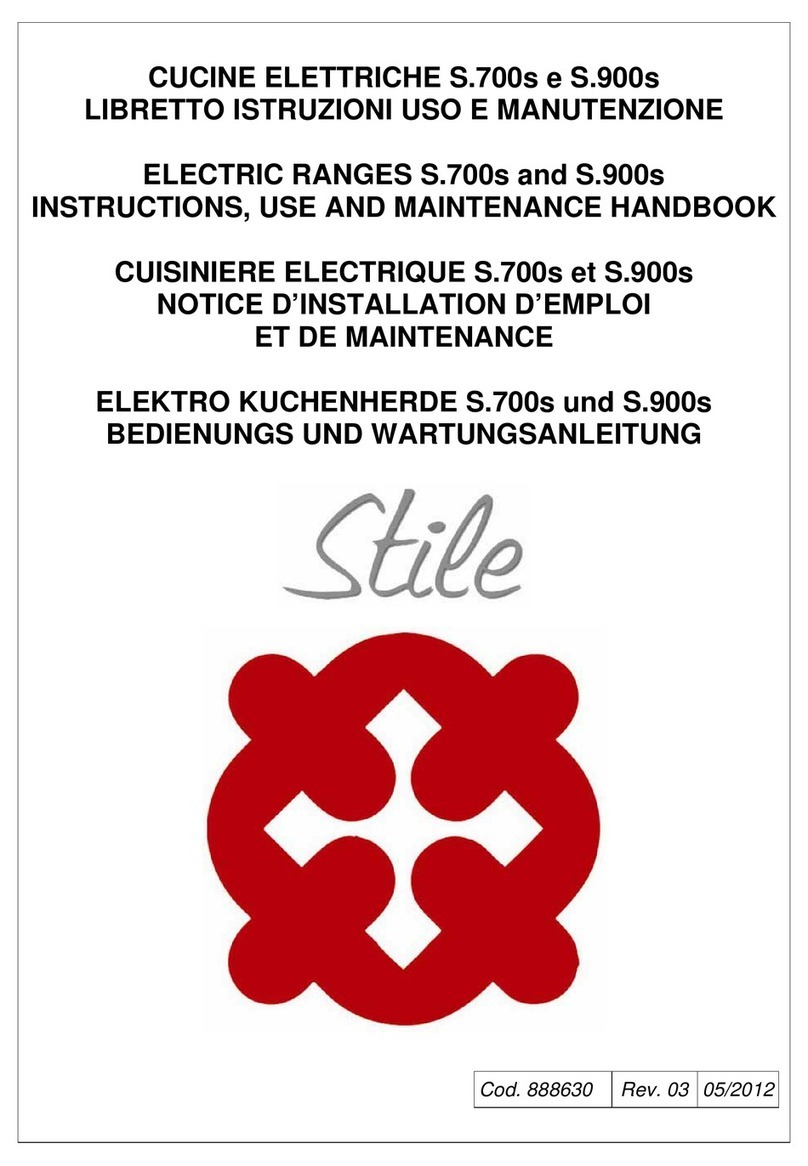
9
1. GENERAL INSTRUCTIONS
Read the instructions contained in this handbook carefully as they give important advice concerning safety of installation,
use and maintenance.
Keep this handbook for any further consultation by the various operators.
After having removed the packing, make sure the equipment is intact. In case of doubt, do not use the equipment and
contact professionally qualified staff.
Before connecting the equipment, make sure that the rating corresponds to that of the gas and electricity mains.
The equipment must only be used by staff trained in use of the same.
Before carrying out cleaning and maintenance, disconnect the equipment from the electricity and/or gas supply system.
Switch the equipment off in the case of a fault or malfunctioning. For any repairs only contact an authorised technical
service centre and request the use of original spare parts.
Failure to observe the above may jeopardise safety of the equipment.
Connection, installation of the system and appliances, ventilation and fumes extraction must be carried out according to
The electrical safety of this equipment is only ensured when it is correctly connected to an effective earthing system as
laid down by current electrical safety regulations.
This fundamental safety requirement has to be checked and, in case of doubt, an accurate check on the system by
professionally qualified staff requested. The manufacturer cannot be considered liable for any damage caused by failure
to earth the system.
This equipment must only be used for the purpose for which it was specifically designed.
Do not wash the equipment with direct, high pressure jets of water.
Do not obstruct the openings or vents for extraction or release of heat.
So as to avoid the risk of rust or chemical attack in general, the stainless steel surfaces have to be kept properly clean.
Clean the parts in stainless steel daily with warm, soapy water, then rinse thoroughly and dry carefully.
On no account should the stainless steel be cleaned with steel wool pads, brushes or scrapers in standard steel, in that
they could deposit ferrous particles which, by oxidising, cause rust spots. Stainless steel wool can, if necessary, be used
in the direction of the satin finish.
Should the equipment not be used for long periods, close the gas valve and wipe all the steel surfaces vigorously with a
cloth moistened with Vaseline oil in order to apply a protective layer; also air the rooms periodically.
Before carrying out the connection, check on the technical data plate that the appliance has been tested and type-
approved for the type of gas available on the use
The manufacturer of the appliance declines every responsibility for possible mistake contained in this booklet imputable to
printing or transcription errors. It also reserves the right to bring changes to the product if retains useful or necessary
without jeopardizing the essential characteristics.
The manufacturing company declines any and every responsibility if the rules brought in this manual are not strictly
observed.
The manufacturer of the appliance declines all responsibility for damage caused by faulty installation, tampering with the
appliance, improper use, poor maintenance, failure to observe local regulations and unskilled use.
THE DISCHARGE OF MACHINE WHEN NO MORE OF USE MUST BE DONE IN COMPLIANCE WITH LAW. THE
MACHINE MUST BE DELIVERED TO FIRM AUTHORIZED FOR THE DISCHARGE OF MACHINE AND OF ITS
COMPONENTS.
2. INSTALLATION
2.1 Installation of the appliance
The operations of installation, any conversion for use with other types of gas, start-up and the remedying of any faults in
the systems, must only be carried out by qualified staff, in accordance with current laws.
The gas and electrical systems and the rooms where the appliances are installed must fulfil the regulations existing in the
various areas and in particular consideration must be made of the fact that the air required for combustion of the burners
is equal to 2 m3/h per kW of installed power and that accident prevention regulations must be observed.
2.2 Installation
Remove the appliances from the packing and position them in the place of use, levelling them and regulating their height
by means of the adjustable feet or other means.
Remove the protective film from the external panels, detaching it slowly to prevent the glue from remaining.
It is important that the walls adjacent to the appliance are protected against the heat. Place refractory sheets in between
them place the appliances at least 200 mm away from the side or rear walls.
2.3 Fumes extraction
The appliances must be installed in rooms suitable for the extraction of combustion products, in accordance with the
provisions of the installation instructions. Our equipment is considered (see specifications table) as:
“A1” TYPE GAS APPLIANCES
The A type appliances must be installed in sufficiently ventilated places in order to prevent the concentrations of harmful
substances in the room where the unit is installed. They are not designed to be connected to a discharge line of




























